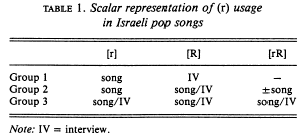This article considers language variation within one “ethnic” group: Israelis of Middle Eastern origins. Earlier studies (Yaeger-Dror, 1988, 1991) found that singers from the dominant “koiné” -speaking social group (Blanc, 1968) use [r] in pop songs and [R] in casual interviews. This can be defined as a register distinction. On the other hand, singers from a MidEastern ethnolinguistic background, whose underlying dialect includes [r], use [R] even in songs. Given that singers whose vernacular consonant invetory does not even include [r], and who should find it easire to use it categorically, have such a difficult time maintaing [r] consistently (and appropriately) in the song register? One of the recorded variants for these singers “merges” the [r] and [R] into coarticulated [rR]. Why does this previously unattested sound arise, and what does it tell us about the linguistic and sociolinguistic situation? Data from various registers are analyzed in order to discover the answers to these questions. This analysis is concerned with the quantifiable evidence of systematic patterns in the use of these three pronunciations for [r] and uses this evidence to demonstrate that subconscious sociolinguistic pressures on members of the minority community influence them to assimilate to the dominant social group while still retaining ethnolinguistic proof of a narrower ethnic identity. For example, the use of [rR] is found to be correlated with a wish to affiliate with both an [R]-using group and an [r]-using group, showing that sociolinguistic techniques can reveal social psychological ethinc affiliation. Like Trudgill's (1986) discussions of dialects in contact, the present theoretical discussion takes advantage of proposals advanced by Giles, to explain why the data reveal both convergence (toward the dominant out-group) and divergence (toward the in-group) (Giles & Coupland, 1991). Sociolinguistic methods permit a quantitative analysis of the strength of these conflicting tendencies, both of which are subsumed under the technical term “accommodation.” Methods are proposed to determine if choice of the

[R] or [rR] variant is conscious or not, and variable rule analysis reveals that for most of the singers the less cognitive salience, the greater the degree of convergence to the Koiné norm [R]. The linguistic factors that are correlated with the relative degree of salience can be used in future studies when the relationship between convergence toward another dialect or language and relative cognitive salience is also at issue.